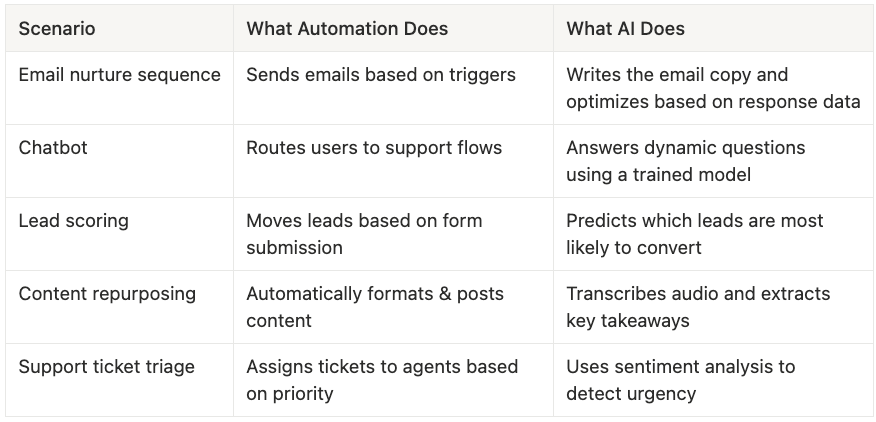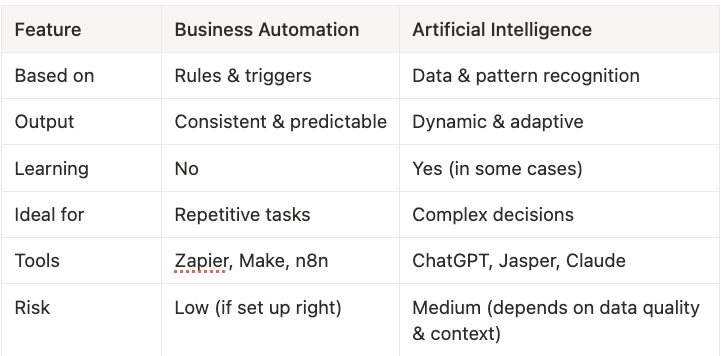The Difference Between Business Automation and AI

Automation is everywhere — from auto-scheduled emails to AI-generated reports. But with all the buzzwords floating around, it’s easy to blur the lines between business automation and artificial intelligence.
So let’s get clear.
- Business automation is about systems.
- AI is about decisions.
They often work together, but they serve different purposes — and knowing the difference can help you build smarter, more effective workflows in your business.
What Is Business Automation?
Business automation refers to the use of rules, logic, and workflows to execute tasks automatically — usually without human involvement.
Key traits of automation:
- Rule-based: “If this happens, do that.”
- Predictable: Works the same way every time.
- Structured: Inputs and outputs are clearly defined.
- Goal: Reduce repetitive work and improve operational efficiency.
Common examples:
- Sending a welcome email when someone joins your list
- Auto-generating invoices every month
- Posting new blogs to social media automatically
- Moving a lead to the next CRM stage when a form is filled out
Popular tools: Zapier, Make, n8n, HubSpot Workflows, Airtable Automations
📌 Think of automation as a digital assembly line.
It’s consistent, fast, and always follows instructions — but it doesn’t “think.”
🤖 What Is Artificial Intelligence (AI)?
Artificial Intelligence refers to systems that can mimic human reasoning, learning, or problem-solving. Unlike automation, AI can analyze data, make decisions, generate content, or improve over time.
Key traits of AI:
- Adaptive: Learns from data or patterns
- Probabilistic: Works with nuance, not rigid rules
- Creative: Can generate content, predictions, or responses
- Goal: Enhance decision-making, personalization, or problem-solving
Common examples:
- Chatbots that answer complex customer questions
- AI writing tools that generate blog drafts (hi 👋)
- Recommendation engines (like Netflix or Amazon)
- Predictive lead scoring in CRMs
- Image recognition and voice assistants
Popular tools: ChatGPT, Claude, Jasper, Midjourney, OpenAI APIs, Google Vertex AI
📌 Think of AI as a digital brain.
It doesn’t follow instructions — it interprets them.
🔄 Where Automation and AI Overlap (The Sweet Spot)
Here’s where things get exciting.
When you combine automation with AI, you get smart systems that not only execute tasks — they adapt, respond, and scale intelligently.
Examples of automation + AI in action:

Together, automation + AI = scalable intelligence.
One handles the grunt work. The other brings the brainpower.
When to Use Automation, AI, or Both
Here’s a quick guide:
✅ Use Automation when:
- The task is repeatable and rule-based
- The output is always the same (or should be)
- You want to save time without needing complex logic
- You’re moving structured data between systems
Example: Automatically move a Stripe customer into your CRM when a payment is made.
✅ Use AI when:
- The task involves unstructured data (text, voice, images)
- You need analysis, predictions, or personalization
- You want the system to “think” or make nuanced decisions
- You’re generating content, insights, or responses
Example: Drafting personalized email subject lines based on user behavior and previous engagement.
✅ Use Both when:
- You want systems that act and think
- You want efficiency and intelligence
- You're building scalable marketing, operations, or support flows
Example:
- AI generates your content
- Automation posts it across platforms, tags it, logs it, and follows up with leads
Key Differences at a Glance

🚨 Don’t Automate Chaos (With or Without AI)
Before adding automation or AI, make sure your underlying processes are solid.
- If the process is messy, automation will just scale the mess.
- If the inputs are unclear, AI will give you unclear results.
- If you don’t know what success looks like, you can’t measure it.
Automation and AI amplify what already exists.
Make sure what exists is worth scaling.
Final Word: Start Simple. Then Get Smart.
You don’t need to choose automation vs. AI, the real magic is in knowing when to use each, and how they can work together.
Start by automating the basics.
Layer in AI when you’re ready to level up.
Keep your systems tight.
And always measure impact.
Next Reads:
📘 The 4 D’s of Automation: Doing, Delaying, Delegating, Deleting
📘 How to Know If Your Business Is Ready for Automation